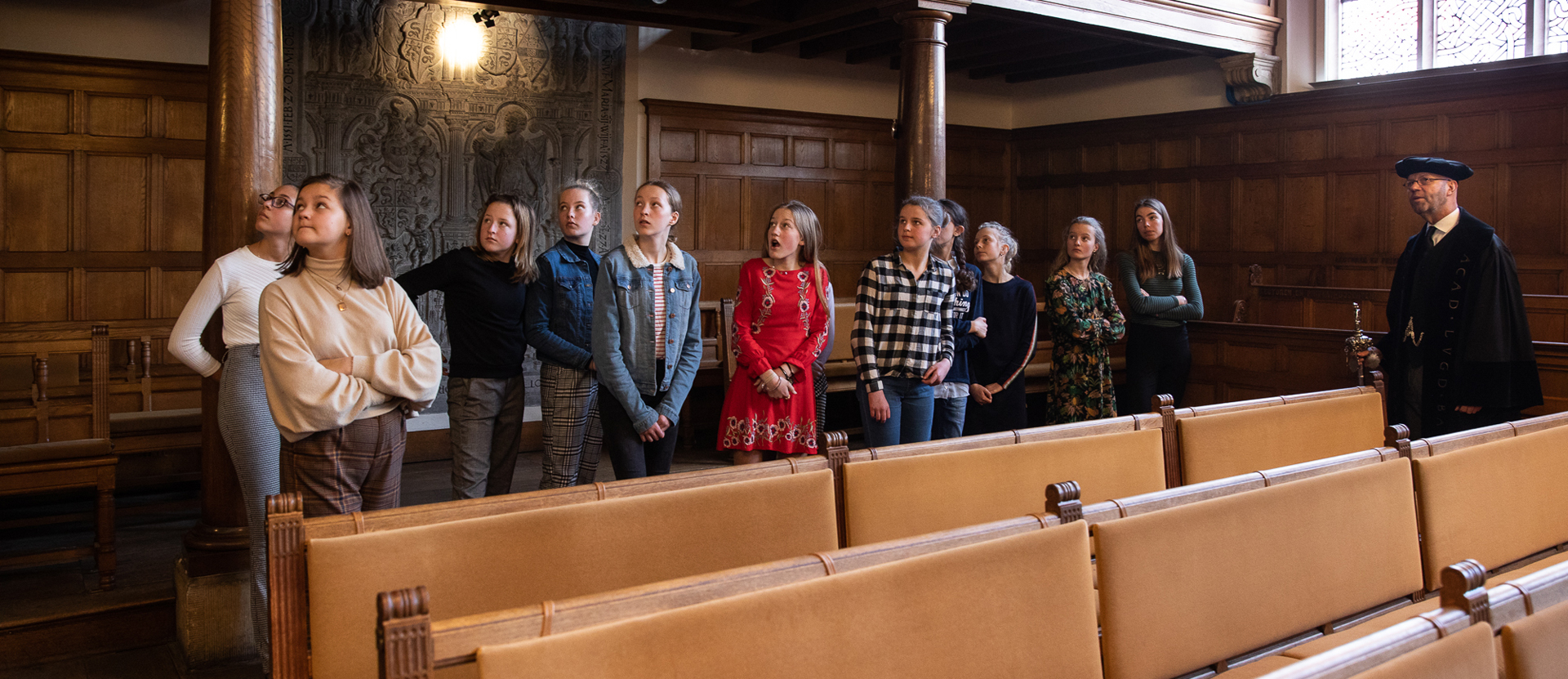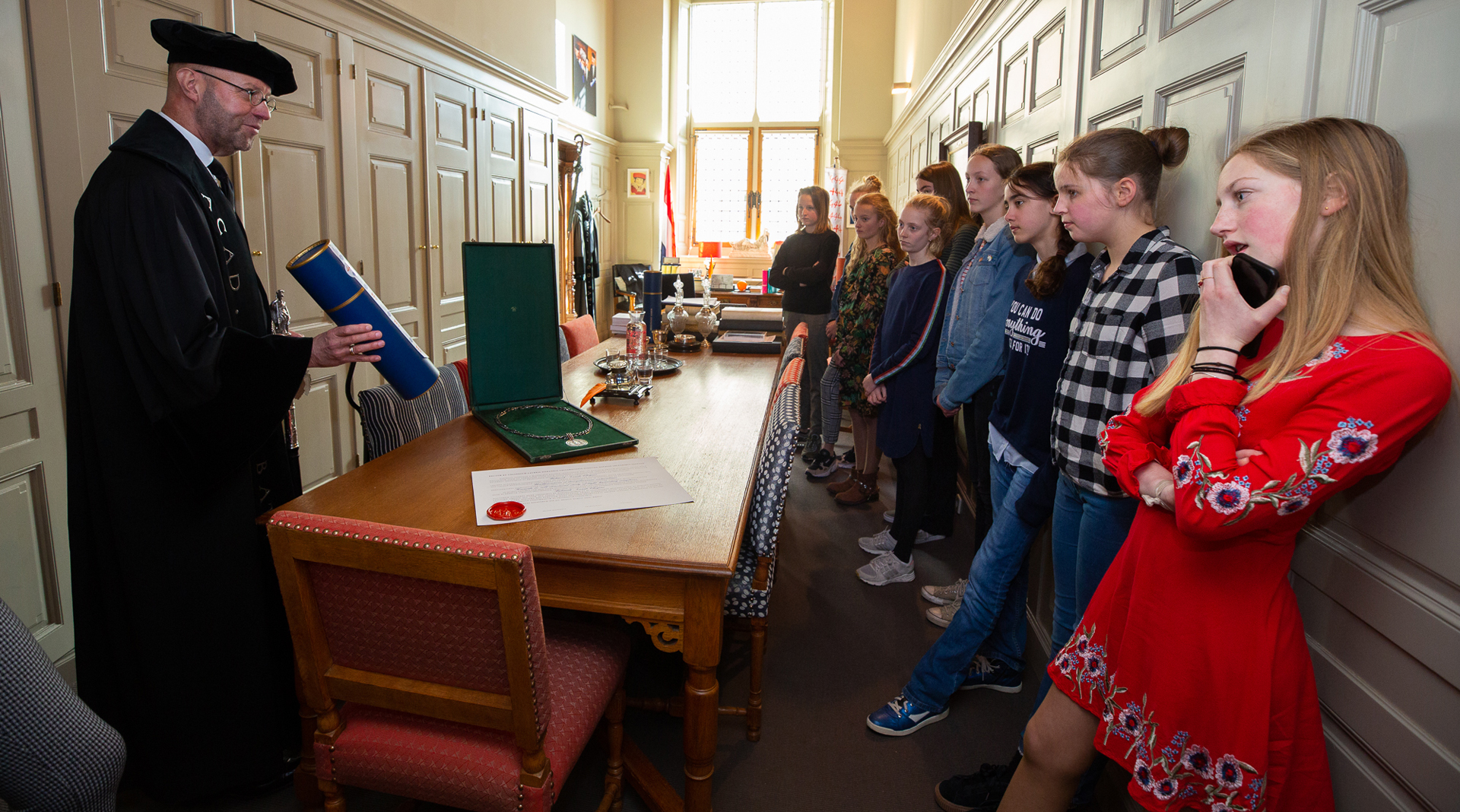
Female professors from the present and the future
Role models are key to inspiring the next generation. Fifteen female professors therefore celebrated International Women's Day with girls aged between 12 and 16. Because although the number of women at the (academic) top is increasing, we're not there yet.
All of the Leiden professors who were appointed with a Westerdijk grant last year were invited to a celebration to mark International Women’s Day on Friday 8 March. They were asked to bring along a girl aged between 12 and 16. Daughters, neighbours, daughters’ friends, friends’ daughters... alongside the 15 professors, 12 girls joined in the celebration at the Academy Building. They were served lunch and an interactive programme.
Scientist is a man
Stephanie and Merle (both 14) came with Professors Ellen de Bruijn and Berna Güroglu. ‘I think it’s important to mark International Women’s Day and think about women’s role in academia. This is a great initiative,’ said Güroglu.
‘I’d never been to a university before,’ said Merle, ‘so I was glad when my neighbour asked me along!’ The female professors look completely different from how she’d expected. ‘I imagine a scientist to be an old man with grey hair.’
‘And glasses,’ laughed Stephanie.

Stereotypes about the roles of men and women
Judi Mesman repeatedly returned to this stereotype in her mini-lecture. ‘Ask children, young people or adults to draw a scientist and 90% will draw an older white man in a white coat,’ said the Professor of Interdisciplinary Study of Societal Challenges. Where does the image come from? Mesman showed examples of our ingrained ideas about men and women. Girl things are pink; boy things are blue. Girls are given toys like a make-up set or a vacuum cleaner; boys a microscope or doctor’s bag. ‘And we even see this difference in school books: men are shown in certain jobs, carpenters or scientists for instance, and women are nearly always depicted as a parent.’
Importance of role models
This is despite there being little difference in the level of girls and boys at secondary school. ‘Their average marks are more or less the same – if any difference is found, then girls are a bit better.’ That is what makes it important for girls to see clever role models more often, such as the top female academics today, said Mesman. ‘Because research has shown that if you then ask someone to draw a scientist they are more likely to draw a woman.’

Mortarboards off to...
The knowledge of the women and girls was also tested in a quiz: mortarboards off or mortarboards on? Everyone knew whether there are equal numbers of female and male professors at Leiden University. ‘It’s not the case yet, it’s true,’ said quizmaster Vice-Rector Hester Bijl. ‘But with 29% female professors, we’re moving in the right direction and are doing all we can to ensure the number continues to increase.’ The question about whether men or women are better at navigating got a laugh from the room. The answer: they’re equally good, but men often think they’re better at it. And despite all their academic knowledge, the professors cast a sneaky glance at their young guests before answering the question of what the Dutch word skeer means!


For Maartje (15), this wasn’t her first time in the Academy Building: she came to the inaugural speech of her mother, Professor of Africa Studies, Marleen Dekker, last year. ‘I asked Maartje to join me because I like to do things together anyway. And I also like to share my work with her, what it’s about, what it entails. And I think she’ll go to university when she’s older...’
‘I definitely will, Mum,’ Maartje interjected. What exactly would she study? And would she become a professor too? ‘No idea yet.’

Still some way to go
Rector Carel Stolker was also there. ‘It’s an odd feeling to be the only man amongst all these women. But for women, this was the case for a very long time: our first female professor, Sophia Antoniadis, for instance. Imagine how she felt to be the only woman in a man’s world.’ It’s only logical that the University should try to achieve a more equal male-female ratio in academia, said Stolker. ‘It’s obvious that more women should get to the top. But days like this, activities like these, are a good way to remind ourselves every now and then, to make us extra aware of what we still have to achieve.’
Text: Marieke Epping
Photos: Monique Shaw
Mail the editors
-

Guided tour of the Academy Building by the beadle. -

-

